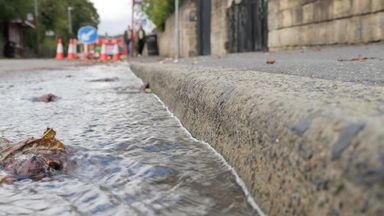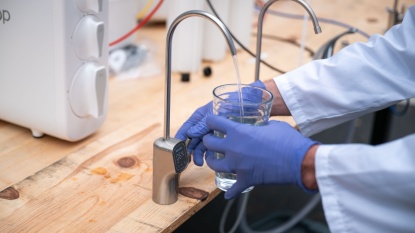Could the UK run out of drinking water? Experts say ‘fast changes’ needed – Sky News

Report on UK Water Scarcity and Alignment with Sustainable Development Goals
1.0 Executive Summary: An Impending Water Crisis
The United Kingdom is facing a significant water security challenge, with expert analysis indicating a potential future deficit in drinking water supply. This situation presents a direct threat to the achievement of several Sustainable Development Goals (SDGs), most notably SDG 6 (Clean Water and Sanitation). Urgent and comprehensive changes in water management, infrastructure, and consumption are required to mitigate this risk and ensure sustainable water resources for future generations, in line with SDG 11 (Sustainable Cities and Communities) and SDG 12 (Responsible Consumption and Production).
2.0 Current Situation and Projections
Recent environmental data highlights the severity of the issue, with conditions creating significant water stress across the nation.
- Driest Period: The initial seven months of 2025 were recorded as the driest since 1976.
- Reservoir Levels: According to the Environment Agency, reservoirs across England were at an average capacity of only 56.1%.
- Future Shortfall: Government projections estimate that by 2050, England could face a daily water shortfall of five billion litres.
These statistics underscore a critical challenge to SDG 6, which aims to ensure the availability and sustainable management of water for all.
3.0 Core Challenges to Sustainable Water Management (SDG 6 & SDG 12)
The current water crisis is exacerbated by systemic inefficiencies in both infrastructure and consumption patterns, which conflict with the principles of SDG 6 and SDG 12 (Responsible Consumption and Production).
- Infrastructure Deficiencies: An estimated 2,690 megalitres of water are lost daily in England due to leaks. This volume is equivalent to 1,076 Olympic-sized swimming pools, representing a major failure in efficient resource management as mandated by SDG 6.4 (substantially increase water-use efficiency).
- Consumption Habits: Experts note a societal tendency to take water for granted, leading to unsustainable usage. A shift towards responsible consumption is essential to align with SDG 12.2 (achieve the sustainable management and efficient use of natural resources).
- Insufficient Storage: Existing water storage infrastructure is proving inadequate to cope with changing climatic conditions, necessitating new solutions to secure supply.
4.0 Climate Change Impact and Resilience (SDG 13 & SDG 11)
The escalating water stress is intrinsically linked to climate change, directly impacting the UK’s progress towards SDG 13 (Climate Action) and the resilience of its communities under SDG 11.
- Increased Temperatures: Professor Hannah Cloke of Reading University warns that summers are projected to become hotter, intensifying pressure on water resources.
- Erratic Rainfall: The Met Office reported that August rainfall was only 62% of the average. Community leaders, such as Simon Tilly of the Hockerton eco housing project, express concern over a systemic collapse, with weather patterns becoming more volatile, leading to longer droughts and more severe floods.
These factors threaten to undermine the resilience and adaptive capacity of communities, a key target of SDG 13.1, and challenge the creation of sustainable and safe human settlements as outlined in SDG 11.
5.0 Proposed Interventions and Strategic Responses
In response to the growing pressure, governmental and corporate entities are initiating actions aimed at bolstering water security. These measures are critical for advancing the aforementioned SDGs.
5.1 Government and Corporate Investment
The Department for Environment, Food and Rural Affairs has acknowledged the challenge and outlined a significant investment plan.
- A total of £104 billion in private investment is allocated for infrastructure renewal and development.
- Key objectives include repairing leaking pipes and constructing nine new reservoirs to secure future water supply, directly contributing to SDG 6.
- Anglian Water has committed an additional £10 million specifically to address weather-related issues and plans to build two new reservoirs in the East of England.
5.2 Community-Level Adaptation
Local initiatives are demonstrating proactive adaptation and a commitment to responsible resource management.
- The Hockerton eco housing project in Nottinghamshire exemplifies a community-led approach to water conservation by harvesting rainwater and collectively reducing consumption. This model aligns with the principles of SDG 11 and SDG 12.
6.0 Conclusion
The evidence strongly suggests that the UK’s water supply is under severe threat from a combination of climate change, inadequate infrastructure, and unsustainable consumption. To avert a future crisis and meet its commitments to the Sustainable Development Goals, particularly SDG 6, SDG 11, SDG 12, and SDG 13, a rapid and coordinated transformation of water management is imperative. This includes substantial infrastructure investment, policy changes to encourage conservation, and a broad public awareness campaign to foster a culture of responsible water use.
Analysis of Sustainable Development Goals in the Article
-
Which SDGs are addressed or connected to the issues highlighted in the article?
The article primarily addresses issues related to water scarcity, infrastructure, and climate change, connecting directly to several Sustainable Development Goals (SDGs).
- SDG 6: Clean Water and Sanitation – This is the most central SDG discussed. The article’s core theme is the impending shortage of drinking water in the UK, low reservoir levels, and the need for water conservation and management.
- SDG 13: Climate Action – The article explicitly links the water crisis to climate change. Professor Hannah Cloke states, “our summers are only going to get hotter,” and Simon Tilly expresses concern about “longer droughts” and “random patterns” in weather, which are direct consequences of a changing climate.
- SDG 9: Industry, Innovation and Infrastructure – The article discusses the critical role of infrastructure in managing the water supply. It mentions government and private investment in “fixing leaking pipes” and building “nine new reservoirs,” which are key components of resilient infrastructure.
- SDG 11: Sustainable Cities and Communities – The article touches upon the need for communities to adapt to water stress. The example of the “Hockerton eco housing project” where residents “collect all our own water from the rain” and work “together to use less water” highlights community-level action towards resource efficiency and resilience.
-
What specific targets under those SDGs can be identified based on the article’s content?
Several specific targets can be identified by analyzing the problems and solutions presented in the article.
- Target 6.4: By 2030, substantially increase water-use efficiency across all sectors and ensure sustainable withdrawals and supply of freshwater to address water scarcity. The article directly addresses this target by highlighting the risk of running out of drinking water, the projected “shortfall of five billion litres of water every day” by 2050, and calls for “fast changes to the way that we are using water.”
- Target 13.1: Strengthen resilience and adaptive capacity to climate-related hazards and natural disasters in all countries. The water shortage is presented as a direct result of a climate-related hazard (drought), with the article noting that the “first seven months of 2025 were the driest since 1976” and the UK received “just 62% of its average rainfall.” Efforts to build new reservoirs and manage water are measures to strengthen resilience.
- Target 9.1: Develop quality, reliable, sustainable and resilient infrastructure… to support economic development and human well-being. The article details plans for infrastructure development, including “over £104bn of private investment to fix leaking pipes” and the construction of new reservoirs. This is a direct response to the failing or inadequate current infrastructure, which loses “2,690 megalitres of water… every day… through leaks.”
-
Are there any indicators mentioned or implied in the article that can be used to measure progress towards the identified targets?
Yes, the article provides several quantitative and qualitative indicators that can be used to track progress.
- Indicator for Target 6.4 (Level of water stress): The article provides specific data points that measure water stress.
- Reservoir levels are stated to be “only 56.1% full on average.”
- A projected water shortfall is quantified as “five billion litres of water every day” by 2050.
- The volume of water lost through inefficient infrastructure is measured at “2,690 megalitres of water… every day in England through leaks.”
- Indicator for Target 13.1 (Resilience to climate hazards): The article implies indicators by describing the severity of the climate-related hazard.
- Rainfall deviation from the average is mentioned: “the UK received just 62% of its average rainfall.”
- The historical context of the drought is provided: “the driest since 1976.”
- Indicator for Target 9.1 (Infrastructure investment): Progress on infrastructure development is measured through financial investment and project numbers.
- Financial commitment is specified: “over £104bn of private investment” and an “extra £10m” from Anglian Water.
- The number of new infrastructure projects is mentioned: plans to “build nine new reservoirs.”
- Indicator for Target 6.4 (Level of water stress): The article provides specific data points that measure water stress.
SDGs, Targets, and Indicators Summary
| SDGs | Targets | Indicators Identified in the Article |
|---|---|---|
| SDG 6: Clean Water and Sanitation | Target 6.4: Substantially increase water-use efficiency and address water scarcity. |
|
| SDG 13: Climate Action | Target 13.1: Strengthen resilience and adaptive capacity to climate-related hazards. |
|
| SDG 9: Industry, Innovation and Infrastructure | Target 9.1: Develop quality, reliable, sustainable and resilient infrastructure. |
|
| SDG 11: Sustainable Cities and Communities | Target 11.5: Reduce the number of people affected by water-related disasters. |
|
Source: news.sky.com
What is Your Reaction?
 Like
0
Like
0
 Dislike
0
Dislike
0
 Love
0
Love
0
 Funny
0
Funny
0
 Angry
0
Angry
0
 Sad
0
Sad
0
 Wow
0
Wow
0


















































.jpg.webp?itok=0ZsAnae9#)






/environment-climate-change-and-health-(ech)/water-sanitation-hygiene-and-health-(wsh)/landfill-tuvalu-36092.tmb-1200v.jpg?sfvrsn=5c21fe40_1#)

















